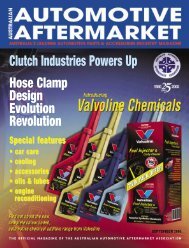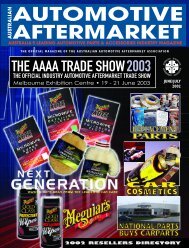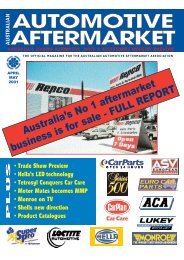AM MAGAZINE SHELL - Australian Automotive Aftermarket Magazine
AM MAGAZINE SHELL - Australian Automotive Aftermarket Magazine
AM MAGAZINE SHELL - Australian Automotive Aftermarket Magazine
You also want an ePaper? Increase the reach of your titles
YUMPU automatically turns print PDFs into web optimized ePapers that Google loves.
TECHNICAL COLUMN<br />
Alternative fuels<br />
The long-term objectives of alternative fuels for automotive use are<br />
sustainability and greenhouse gas reduction and therefore little is<br />
gained by looking at fossil fuels except where these are in abundant<br />
supply relative to the availability of oil. With the diversification of fuels<br />
available, it is necessary to consider the complete ‘fuel’ chain to<br />
understand the total impact on the environment from production,<br />
processing, transportation, distribution etc through to the use in a<br />
vehicle.<br />
One such study was conducted by Toyota in conjunction with<br />
Mizuho Research Institute to estimate Greenhouse Gas Emissions<br />
(GHG) on a “Well to Wheel” (fuel extraction through to power at the<br />
wheels) basis for many different fuel types. Using an index of 1 for<br />
petrol, some of the results are very interesting. For example a petrol<br />
hybrid is 0.45 (lower score means lower GHG impact), a diesel hybrid<br />
about 0.35, LPG and CNG are approximately the same at 0.8, for<br />
electricity produced by coal 1.2 (worse than petrol) whereas for nuclear<br />
power generation the result is 0; ethanol produced from sugar cane<br />
0.2 and synthetic diesel produced from biomass 0.1. A fuel cell using<br />
CNG is 0.4 whereas a fuel cell using liquid hydrogen is 0.2.<br />
Apart from Greenhouse Gas Emissions, other factors that must be<br />
considered to establish the viability of an alternative fuel include cost,<br />
infrastructure, supply potential and usability which will now be<br />
examined in more detail for fuel types which are the most likely to meet<br />
these criteria.<br />
Ethanol<br />
Ethanol, also known as Ethyl Alcohol, is a clear and colourless<br />
liquid, which is produced from vegetable and plant based materials.<br />
Today most ethanol is produced from starch and sugar based feedstock<br />
such as corn, sugar cane etc. Given the potential impact on food<br />
production, much research is being undertaken to use cellulosic<br />
feedstock. Cellulosic feedstock includes agricultural and forest<br />
residues, grasses, municipal waste and trees.<br />
The reason that ethanol scores so highly in the “Well to Wheel”<br />
index is that the carbon dioxide used to convert feedstock to ethanol<br />
is a little more than the carbon dioxide captured by the crops during<br />
growth.<br />
Ethanol works well in internal combustion engines as it is a highoctane<br />
fuel, suitable for high compression ratio engines, but contains<br />
about 34 percent less energy than petrol. Low-level blends such as<br />
E10 (90 percent petrol, 10 percent ethanol) are readily available in<br />
Australia and high level blends up to E85 (85 percent ethanol, 15<br />
percent petrol) are available in countries such as USA, Brazil and<br />
Sweden.<br />
Synthetic diesel<br />
Synthetic diesel is a method of producing diesel fuel from natural<br />
gas, which is one Earth’s cleanest and most abundant natural<br />
resources. Synthetic diesel is made by using a conversion technology<br />
called the Fisher-Tropsch process, which converts natural gas into the<br />
synthetic diesel, which can then be used in any petroleum diesel fuel<br />
application.<br />
Synthetic diesel provides numerous economic and environmental<br />
benefits over typical petroleum diesel. First of all, synthetic diesel is<br />
sulphur free and free of other petroleum by-products. This means that<br />
synthetic diesel is significantly cleaner, cleaner burning and can be<br />
formulated for superior cold weather performance and fuel system<br />
lubricity. Because synthetic diesel has fewer contaminants, it is lower<br />
in toxicity and it also has a higher cetane rating, like octane for petrol,<br />
it offers better performance over regular petroleum diesel. Synthetic<br />
diesel can be blended with standard diesel and stringent diesel exhaust<br />
emission standards are compelling the petroleum industry to revisit<br />
FIG 2: Mercedes Benz ‘B’ Class Fuel Cell vehicle<br />
synthetic diesel to competitively produce aromatic and sulphur<br />
complying diesel fuel.<br />
Since the late 1990’s nearly every major oil company announced<br />
plans to build pilot plants or commercial plants to produce synthetically<br />
derived diesel fuel. Shell is currently building the largest gas to oil<br />
refinery in the world in Qatar, and when completed, will have a capacity<br />
of 140,000 barrels/day of diesel and other products.<br />
Fuel cells<br />
Fuel Cells have been extensively used throughout the space program<br />
and many vehicle manufacturers believe that fuel cells are the<br />
technology of the future. Mercedes Benz will release a limited<br />
production version of a fuel cell ‘B’ series next year as will Honda with<br />
the FCX Clarity.<br />
Fuel cells convert the chemical energy in hydrogen to electricity,<br />
with pure water and potentially useful heat as the only by-products.<br />
Hydrogen powered fuel cells are not only pollution free, but also have<br />
more than twice the efficiency of traditional combustion technologies.<br />
A combustion-based power plant generates electricity at efficiencies<br />
of 35 percent while fuel cells are up to 60 percent efficient. The<br />
conventional automotive engine is around 20 percent efficient in<br />
converting the chemical energy of petrol into power at the wheels.<br />
Hydrogen fuel cell vehicles, which use electric motors, are much more<br />
efficient using 40-60 percent of the fuel energy.<br />
There are a number of ways that hydrogen can be provided to the<br />
fuel cell. Hydrogen gas can be stored as a gas or liquid hydrogen but<br />
to carry gaseous hydrogen it must be compressed at very high pressures<br />
in special fuel tanks similar to compressed natural gas. Liquid nitrogen,<br />
used in the space shuttle, is super-cold so the fuel tank would need to<br />
cope with high pressures and be super insulated.<br />
Another way to provide hydrogen to the fuel cell is to use a<br />
‘reformer’. A reformer is a device that removes the hydrogen from<br />
hydrocarbon fuels, like methanol, natural gas, LPG or petrol. When a<br />
fuel other than hydrogen is used, the fuel cell is no longer zero<br />
emission, but still very low emitting.<br />
The challenges facing fuel cell development are to reduce cost and<br />
improve durability to cope with the dynamics and vibration of a motor<br />
vehicle. In addition, the distribution costs of hydrogen on a large scale<br />
to fuel motor vehicles will be prohibitive and it is likely that initial use<br />
of this technology will be via the use of an onboard reformer using<br />
methanol, natural gas or LPG as the fuel.<br />
Whilst highly speculative, a 100 year forecast of automotive fuel<br />
supply by General Motors and Shell shows that petroleum based fuels<br />
will continue to dominate energy demand (around 78 percent) until<br />
2050, By the end of the century, petroleum based fuel energy demand<br />
will drop to around 25 percent whereas synthetic fuels and bio-fuels<br />
will account for 50 percent and hydrogen/electricity will meet the other<br />
15 percent.<br />
AU T O M O T I V E A F T E R M A R K E T M AG A Z I N E D E C E M B E R 2 0 0 9 21

















